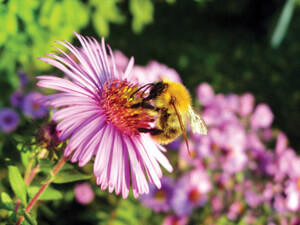
This month our topic will be a diversion from subjects we usually discuss. This article is about plants. First it is necessary to acknowledge and reference the author in this journal who has covered the subject for many years. I will not try to reference every plant covered by Dr. George S. Ayers. Rather, I will refer to his column as the better source of information on the plant species discussed herein. His articles on each species are interesting and complete with regard to each species mentioned in this article. Any beekeeper with property available to plant forage for kept colonies would be well advised to follow the information from Michigan State University provided by him.
It has been and remains the practice of most state highway departments to help out our farmers by controlling noxious weeds, including many alien species, along the roadways everywhere in the country. This practice is important to agriculture and this article will not suggest we stop the control of noxious weeds that spread along our highways. Killing weed pests along our highways is necessary for agriculture production. I will suggest that we use a rifle approach in the future instead of the shotgun approach now most often implemented.
Most state highway departments are using 2,4-D herbicide to kill noxious weeds along the roadsides all over the country. The herbicide is a good choice; it is inexpensive, safe and will kill most broadleaf weeds. State highway departments typically spray a broadcast application in daylight hours. For those of us who reside beyond the sidewalks, this sometimes results in drift that injures or even kills desired plants for landscaping or gardens. If the state highway departments would use a rifle approach, with a straight stream of herbicide directed at only the noxious weed in question, it would eliminate most drift and not kill all of the broadleaf plants along our roadsides.
I am suggesting a new policy for all the states because we need pollinator friendly plants along our roadsides. Monarch butterflies have been declared an endangered or threatened species in some states. These butterflies have noticeably declined in the Mississippi flyway during the past 2 – 3 decades. By now you will realize that many honey bee forage plants have been destroyed by broadcast spraying along the nation’s highways. Where I am going with this line of thought? We beekeepers recommend that all highway departments intentionally plant pollinator-friendly flowering species along our roadsides, allowing perennial pollinator forages to bloom uninterrupted without mowing during the warm months. There is so much rhetoric about threats to pollinators, including bumble bees, monarch butterflies and most importantly honey bees. One of the biggest threats is lack of variety in pollen and nectar sources. Our highways are a naturally available location to help pollinators everywhere in our nation.
The first species we will suggest helps bees but also is essential for monarch butterflies. Swamp milkweed, Asclepias incarnata, is the best species wherever soils are moist and even wet. Common milkweed, Asclepias tuberosa, will be better in hilly well drained areas. Milkweed flowers are pink, orange, red or purple and form a flower referred to as an umbel. These have a wide flat floral surface above a long stem. It is these flowers that share their name origin with our rainy day tool the umbrella. They bloom in summer, are easily cultivated, and produce attractive flowers with ornamental value. Flowers will improve the appearance of our roadsides while helping our pollinators. Why would we not want to do this?
Asters are some of the most common flowers of all. There are about 500 species and some are native all over the country. Bees forage readily on these beautiful flowers everywhere. Many species are perennial, but others are annual and biannual. The annual and biannual species readily reseed themselves. They are about every color we can think of. Asters are available from spring through fall if enough different species are cultivated. Two of the most common are dandelions and sunflowers. Goldenrods are also asters. All of these plants make excellent honey bee forage in spring and summer. There are ample varieties of dwarf sunflowers to use. Most wild native asters can be propagated by seed and will potentially provide pollen and nectar for bees all season.
There are numerous plants in the legume family that provide good pollinator forage. Several we commonly grow for.…
Photo Caption
Purple Aster


